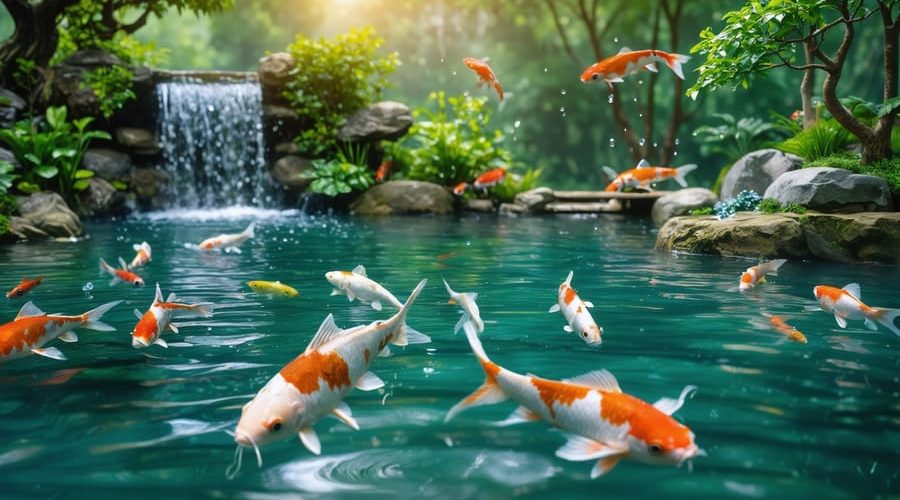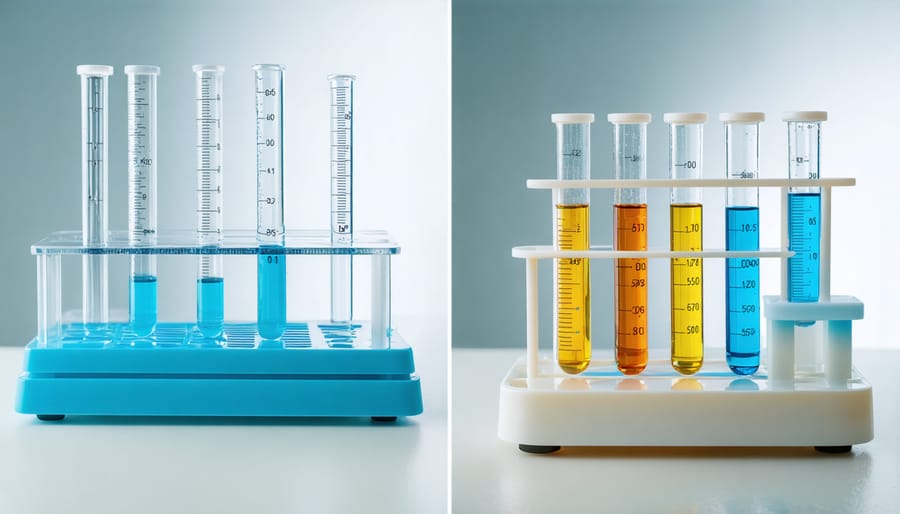
Keep Your Koi Happy: Essential Pond Maintenance Made Simple
Transform your koi pond from a maintenance challenge into a thriving aquatic paradise with proper care and attention. Daily water quality checks, regular filter cleaning, and seasonal adjustments form the backbone of successful koi pond maintenance. Whether you’re a novice pond keeper or a seasoned enthusiast, mastering these essential care routines protects your valuable koi while creating a stunning water feature that enhances your outdoor space.
A well-maintained koi pond isn’t just about keeping fish alive—it’s about creating an ecosystem where these living jewels can flourish and display their full potential. From monitoring ammonia levels to balancing beneficial bacteria, each maintenance task plays a crucial role in your pond’s health. Let’s dive into the fundamental practices that will help you maintain crystal-clear water, healthy koi, and a beautiful pond that brings joy year after year.
Water Quality: The Foundation of a Healthy Koi Pond
Testing Water Parameters
Regular water testing is crucial for maintaining a healthy koi pond environment. You’ll want to check key parameters at least weekly, with some requiring daily attention during critical periods. Essential parameters include pH (ideal range 7.0-8.6), ammonia (should be 0 ppm), nitrites (0 ppm), and nitrates (below 20 ppm). Don’t forget to monitor the optimal water temperature, which directly affects your koi’s metabolism and overall health.
I recommend investing in a reliable water testing kit that includes test strips or liquid reagents for all these parameters. While test strips are convenient, liquid test kits typically provide more accurate readings. Keep a logbook to track your readings – this helps you spot trends and potential problems before they become serious.
Testing is particularly important after heavy rain, when adding new fish, or during seasonal changes. If you notice your koi behaving unusually, such as gasping at the surface or becoming lethargic, test your water immediately. Remember, prevention through regular testing is much easier than dealing with water quality problems after they’ve affected your fish.
A simple testing schedule might look like this:
– Daily: Temperature and visual water check
– Weekly: pH, ammonia, nitrites
– Monthly: Nitrates, KH (carbonate hardness)
– Seasonally: Complete water analysis including oxygen levels

Filtration Systems
A reliable filtration system is the heart of any healthy koi pond, working tirelessly to keep your water crystal clear and your fish happy. There are three main types of filters you’ll need: mechanical, biological, and UV filters.
Mechanical filters catch debris like leaves and fish waste, acting as your pond’s first line of defense. These typically use foam or screen materials and need weekly cleaning to prevent clogging. A quick rinse with pond water (never tap water!) will keep them working efficiently.
Biological filters are where beneficial bacteria thrive, breaking down harmful ammonia and nitrites. These can be in the form of moving bed filters, static media, or even constructed wetlands. While they require less frequent maintenance, it’s important to never clean all the media at once to preserve your bacterial colony.
UV filters are your secret weapon against green water, zapping algae as water passes through. These need annual bulb replacement and occasional cleaning of the quartz sleeve to maintain effectiveness.
For smaller ponds, an all-in-one filter system might suffice. Larger koi ponds often benefit from separate components that can be customized to your specific needs. Remember to match your filter size to your pond volume and fish load – bigger is usually better when it comes to filtration!
A well-maintained filter system will reward you with healthy fish and clear water, making the regular maintenance absolutely worth the effort.

Seasonal Maintenance Calendar
Spring Revival
As winter fades away, it’s time to wake up your koi pond from its seasonal slumber. Start by removing any debris that accumulated during winter, including fallen leaves and dead plant material. Once the water temperature consistently stays above 50°F (10°C), carefully inspect your pump and filtration system before restarting them.
Begin running your system at a lower speed initially, gradually increasing it over a few days to prevent shocking your koi. Test your water parameters, paying special attention to ammonia and pH levels, as these can fluctuate during the winter-to-spring transition. Add beneficial bacteria to jump-start your biological filtration system.
Check for any damage to pond liner, rocks, or edging that might have occurred during winter. Trim back any overgrown marginal plants and remove dead foliage. If you used a winter net, now’s the time to remove it. As your koi become more active, begin feeding them with easily digestible spring food, starting with small amounts and gradually increasing portions as water temperatures rise.
Summer Care
Summer brings unique challenges for koi pond maintenance, with rising temperatures and increased algae growth being the main concerns. Keep your pond water temperature below 85°F (29°C) by adding floating plants or installing shade sails. These natural solutions not only cool the water but also reduce algae growth by limiting sunlight exposure.
Monitor oxygen levels carefully during hot weather, as warm water holds less dissolved oxygen. Consider running your waterfall or fountain 24/7 to increase aeration. Adding an air pump or extra air stones can provide crucial oxygen support during heat waves.
Combat summer algae blooms by maintaining proper filtration and regularly removing debris. A UV clarifier can help control floating algae, while barley straw extract serves as a natural algae deterrent. Remember to feed your koi less frequently in extreme heat, as their metabolism changes with water temperature.
Test water parameters more frequently during summer months, paying special attention to ammonia levels, which can spike in warmer conditions. Early morning water testing provides the most accurate readings.
Fall Preparation
As autumn approaches, it’s crucial to prepare your koi pond for the challenges that falling leaves bring. Start by installing a pond net above the water surface to catch leaves before they sink. This simple step saves you countless hours of cleanup and prevents excess organic matter from decomposing in your pond.
Trim back nearby plants and remove dead vegetation around the pond’s edge. Now’s also the time to gradually reduce feeding as your koi’s metabolism slows with dropping temperatures. Check your filtration system and remove any debris that could cause blockages during winter months.
Consider adding beneficial bacteria to help break down any organic matter that does make it into the pond. If you have a skimmer, clean it more frequently during this season. Pay special attention to your pond’s bottom, using a pond vacuum to remove settled debris before it can affect water quality. These preventative measures will make your winter maintenance much easier and help ensure your koi’s health through the colder months.
Winter Protection
As temperatures drop, proper winter pond maintenance becomes crucial for your koi’s survival. Install a pond net before autumn to catch falling leaves and prevent them from decomposing in the water. When water temperatures consistently fall below 50°F (10°C), reduce feeding as your koi’s metabolism slows down.
Keep a small area of the pond surface free from ice using a floating de-icer or pond aerator to ensure proper gas exchange. Never break ice directly on the pond surface, as this can harm your koi. Consider adding a pond heater if you live in an area with severe winters.
For shallow ponds (less than 4 feet deep), you might need to move your koi to indoor quarters during extreme cold. Deeper ponds usually provide adequate protection, as koi naturally move to warmer bottom waters during winter. Monitor water quality regularly, as decomposing matter can still affect parameters even in cold temperatures.
Feeding and Health Management
Seasonal Feeding Guidelines
Feeding your koi correctly throughout the year is crucial for their health and growth. During spring, as temperatures climb above 50°F (10°C), begin with easily digestible wheat germ-based foods. Start with small amounts twice daily, gradually increasing portions as your fish become more active.
Summer is peak feeding season when water temperatures are between 65-75°F (18-24°C). Offer high-protein foods 3-4 times daily, but only what your koi can consume within 5 minutes. Mix in fresh treats like lettuce and oranges occasionally to provide varied nutrition.
As autumn approaches and temperatures drop below 65°F (18°C), reduce feeding frequency to once or twice daily. Switch back to wheat germ-based foods, which are easier to digest in cooler conditions. When water temperatures fall below 50°F (10°C), begin tapering off feeding.
During winter, when temperatures drop below 45°F (7°C), stop feeding completely. Koi enter a semi-dormant state and don’t require food. Their metabolism slows significantly, and feeding during this time can actually harm them by causing undigested food to rot in their systems.
Remember to always check water temperature before feeding and adjust portions based on your koi’s activity level and appetite.

Health Monitoring
Regular health monitoring of your koi is essential for catching potential problems early. Watch for signs like scratching against rocks, gasping at the surface, or unusual swimming patterns, as these could indicate parasites or water quality issues. Healthy koi should be active, eating well, and maintaining vibrant colors.
Keep an eye out for physical symptoms such as red or inflamed gills, white spots, cloudy eyes, or unusual growths on the body. These could signal common koi ailments like parasitic infections or bacterial diseases. If you notice multiple fish showing similar symptoms, it’s crucial to act quickly.
Prevention is always better than cure. Maintain consistent water parameters, avoid overcrowding, and quarantine new fish before adding them to your main pond. Regular water testing and partial water changes help prevent stress-related illnesses. Consider installing a UV sterilizer to control harmful microorganisms.
Create a routine health check schedule, perhaps weekly or bi-weekly, where you observe your koi during feeding time. This helps you become familiar with their normal behavior and makes it easier to spot when something’s amiss. Keep basic medications and treatments on hand, but always consult a koi health specialist for serious concerns.
Common Problems and Solutions
Algae Control
Controlling algae is a constant challenge for koi pond owners, but there are several effective solutions available. Using natural algae control methods like adding aquatic plants can help compete with algae for nutrients. Water lilies and floating plants provide shade, reducing sunlight that algae need to thrive. Installing UV clarifiers is another popular option, as they destroy single-cell algae as water passes through them.
For immediate results, chemical treatments containing algaecides can quickly clear green water, but use these carefully to avoid harming your koi. Always follow dosage instructions and ensure proper aeration when using chemical treatments. Prevention is key – maintain proper filtration, avoid overfeeding your fish, and regularly remove debris that can decay and feed algae growth.
A balanced approach combining natural methods with occasional chemical treatments often works best. Remember that some algae is normal and even beneficial – the goal is management, not complete elimination. Regular water testing helps monitor nutrient levels that contribute to algae growth, allowing you to adjust your control methods accordingly.
Water Clarity Issues
Cloudy or discolored water in your koi pond can be frustrating, but it’s a common issue with several straightforward solutions. Green water typically indicates an algae bloom, which occurs due to excess nutrients and sunlight. To combat this, reduce feeding amounts and consider adding more aquatic plants to compete with algae for nutrients. A UV clarifier can also help eliminate floating algae.
Brown or muddy water often results from suspended particles or debris. This can be addressed by checking your filtration system and ensuring it’s working efficiently. Sometimes, adding a fine filter pad or installing a protein skimmer can help capture smaller particles. If the problem persists, beneficial bacteria supplements can help break down organic matter that contributes to water discoloration.
White or cloudy water usually indicates a bacterial bloom, which often occurs in new ponds or after major maintenance. While this typically clears up on its own within a few days, you can speed up the process by adding beneficial bacteria and ensuring proper filtration. Remember, sudden changes in water clarity might also signal deeper problems with water quality, so regular testing is essential.
Equipment Maintenance
Regular equipment maintenance is crucial for keeping your koi pond healthy and functioning optimally. To maintain your pond pump, clean it monthly to remove debris and check for wear and tear. Listen for unusual noises that might indicate problems, and lubricate moving parts as recommended by the manufacturer.
Your filtration system needs weekly attention to prevent clogging. Rinse filter media in pond water rather than tap water to preserve beneficial bacteria. For mechanical filters, remove and clean the foam or sponge elements when water flow decreases. Biological filters require gentler cleaning to protect the bacterial colonies.
UV systems need regular bulb replacement, typically annually, even if they still appear to be working. Clean the quartz sleeve housing the UV bulb every few months to ensure maximum effectiveness. Remember to switch off all equipment before maintenance and keep electrical components dry.
Check all connections and hoses seasonally for leaks or damage. Replace worn parts promptly to prevent system failures that could harm your koi. Keep spare parts on hand for emergency repairs, especially during peak seasons when equipment works hardest.
Maintaining a koi pond is a rewarding journey that requires dedication and consistent care. By following proper maintenance routines, you’ll create a thriving environment where your koi can flourish for years to come. Remember to check water quality parameters regularly, maintain your filtration system, and keep up with seasonal cleaning tasks to prevent potential problems before they arise.
Make maintenance easier by creating a schedule that works for you, whether it’s daily feeding checks, weekly water testing, or monthly equipment inspections. Stay attentive to your fish’s behavior, as they’re often the first indicators of potential issues in your pond’s ecosystem.
Don’t forget that every pond is unique, and you’ll learn more about your specific system’s needs as time goes on. Be patient with yourself as you develop your maintenance routine, and don’t hesitate to adjust your approach based on what works best for your pond.
With proper care and attention, your koi pond will remain a beautiful, peaceful haven that brings joy to both you and your fish. The time and effort you invest in maintenance will be rewarded with healthy, vibrant koi and crystal-clear water that you can enjoy throughout the year.
